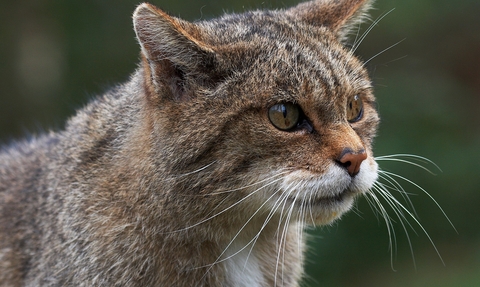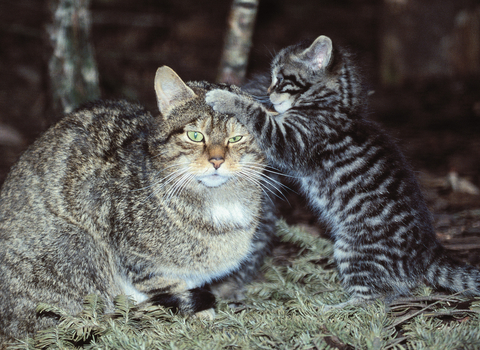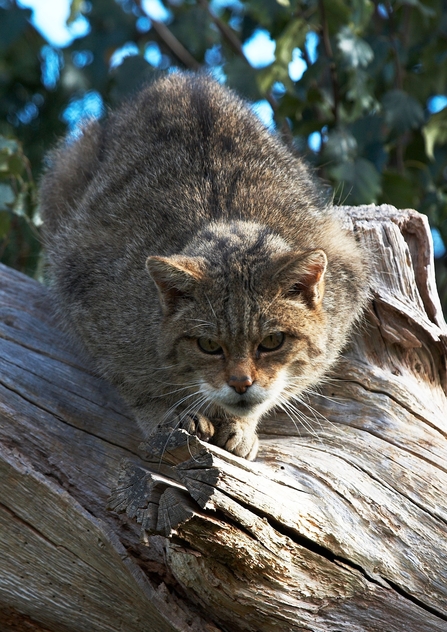
Elliot Smith
Bringing back wildcats
South West Wildcat Project
After an absence of more than 100 years, could wildcats be returned to the South West? Detailed work by a Devon Wildlife Trust led partnership has suggested that they could!
Analysis has identified that the region is ecologically suitable whilst independent research by the University of Exeter has suggested that the South West public likes the idea of this native cat returning. However, it is also recognised that further work is needed to identify suitable release sites and raise awareness around wildcats including how they contribute to a healthy ecosystem. Over the next 1-2 years, Devon Wildlife Trust and partners will work closely with local communities to identify if there are landscapes within Devon ready for wildcats.
Find all reports and studies here
Wildcats were once found throughout Great Britain but were extinct from England and Wales by the mid-18th century because of human persecution. Even in their final Scottish haunts they are critically endangered, and subject to urgent species recovery action.
The South West Wildcat Project is a partnership project between Devon Wildlife Trust, Derek Gow Consultancy and Forestry England. University of Exeter and Wildwood Trust are advisers to the project.
What is a wildcat?
The European wildcat (Felis silvestris) is Britain's only remaining native cat species. They can look similar to a domestic tabby cat (Felis catus) but is larger, stockier and with a distinctive black-banded and blunt-tipped tail. Although they share a common ancestor, wildcats and domestic cats are separate species. Whilst widely distributed across Europe, wildcats in the UK are currently restricted to Scotland, where it inhabits the forested margins of moorland and farmland.

Why bring wildcats back?
The South West was once a stronghold for wildcats in England, but hunting and habitat loss drove them from the region. Today, only a small population survives in Scotland. To safeguard the future of this native and critically endangered species, we must take action — restoring Scottish populations and identifying suitable areas for reintroduction. With no possibility of wildcat populations naturally recovering, reintroduction is the only viable path forward. Wildcats once played an important ecological role in our countryside and, with our help, they could do so once more.
Catch up on our latest online talks
In November 2023, Cath Jeffs, our South West Wildcat Officer, explored how DWT is investigating the feasibility of reintroducing wildcats to South West England. Watch the recording here.
In December 2025, come and hear the results of the DWT led project exploring if it is feasible to reintroduce European Wildcats to South West England.
Book your free space at the online talk.
If you’d like to read more, check out our latest blog exploring Cath’s passion and journey throughout the process of investigating whether wildcats could return to the South West. Read it here.

David R White
Why the South West could support wildcats again
South West England was first identified as an area potentially suitable for re-establishing wildcats in 2019. The Vincent Wildlife Trust study also identified North and West Wales as potential reintroduction sites.
The South West Wildcat Project was therefore established in 2023 to investigate the feasibility of a reintroduction to the region. Its report, concludes:
The South West contains enough woodland cover connected by other suitable habitat to support a sustainable wildcat population. It highlights a well-connected landscape of habitat across mid Devon as potentially the most suitable for reintroductions to take place.
A significant majority of people in the South West expressed positive views towards wildcat reintroduction to their region. Two separate surveys were conducted by independent researchers at the University of Exeter. In one, 71% of 1,000 people (representative of the age and gender of the region’s population) liked the idea of wildcat return. In the other, 83% of 1,425 who responded to an online questionnaire expressed positivity towards wildcat reintroduction. Read the report.
Wildcats pose no significant risk to existing endangered wildlife populations such as bats and dormice. Wildcat diets concentrate on widespread commonly found species, with 75% of their prey consisting of small mammals including voles, rats, wood mice and rabbits. Their presence would help ‘balance’ existing ecosystems by returning a missing predator which co-evolved alongside native wildlife.
Wildcats pose no threat to people, domestic pets or farming livestock such as lambs. Commercial and domestic poultry can be protected from wildcats with the same precautions deployed for existing predators such as foxes.
A review of diseases and hazards associated with wildcats was undertaken by veterinary experts. This found that all diseases identified could be mitigated by good husbandry or specific mitigations.
If you have any questions, take a look at our FAQs.
Next steps
The DWT led partnership has concluded that a wildcat reintroduction is ecologically and socially feasible. However, before any releases are considered, further work is needed to support communities, so that they are ready to live alongside wildcats again. As well as identifying suitable release sites with well-connected wildcat habitat, work to mitigate the risk of interbreeding with domestic cats is needed. Reducing the risk of unneutered domestic cats within wildcat areas is going to require close liaison with animal welfare organisations and domestic cat owners.
Reintroducing species is never easy, but we are committed to continuing to explore bringing back this native predator to South West England. As well as returning a missing species, this will contribute to a national wildcat strategy that looks to improve the status of a critically endangered British species.
At every stage of its work the South West Wildcat Project is following guidelines established by the International Union for Conservation of Nature on the reintroduction of species and Defra. Find the guidelines here.
We are grateful to Devon Environment Foundation and The Benindi Fund for funding the feasibility stage of this project.


